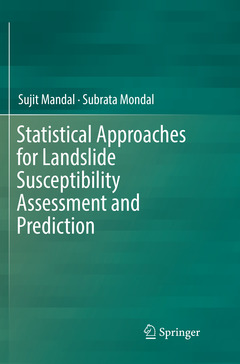Description
Statistical Approaches for Landslide Susceptibility Assessment and Prediction, Softcover reprint of the original 1st ed. 2019
Authors: Mandal Sujit, Mondal Subrata
Language: English
Subjects for Statistical Approaches for Landslide Susceptibility...:
Keywords
landslide modeling; Landslide Susceptibility Assessment and Prediction; Logistic multiple regression; Artificial Neural Networks; monitoring and warning systems; lithology and geomorphology; Landslide Potentiality Index Value; darjiling himalayas; Analytical Hierarchy Process; hazard evaluation; geomorphic; geo-tectonic and geo-hydrologic attributes; mountain environments; hydrogeology
Approximative price 116.04 €
In Print (Delivery period: 15 days).
Add to cartPublication date: 12-2018
Support: Print on demand
116.04 €
In Print (Delivery period: 15 days).
Add to cartPublication date: 09-2018
Support: Print on demand
Description
/li>Contents
/li>Biography
/li>Comment
/li>
This book focuses on the spatial distribution of landslide hazards of the Darjeeling Himalayas. Knowledge driven methods and statistical techniques such as frequency ratio model (FRM), information value model (IVM), logistic regression model (LRM), index overlay model (IOM), certainty factor model (CFM), analytical hierarchy process (AHP), artificial neural network model (ANN), and fuzzy logic have been adopted to identify landslide susceptibility. In addition, a comparison between various statistical models were made using success rate cure (SRC) and it was found that artificial neural network model (ANN), certainty factor model (CFM) and frequency ratio based fuzzy logic approach are the most reliable statistical techniques in the assessment and prediction of landslide susceptibility in the Darjeeling Himalayas. The study identified very high, high, moderate, low and very low landslide susceptibility locations to take site-specific management options as well as to ensure developmental activities in theDarjeeling Himalayas.
Particular attention is given to the assessment of various geomorphic, geotectonic and geohydrologic attributes that help to understand the role of different factors and corresponding classes in landslides, to apply different models, and to monitor and predict landslides. The use of various statistical and physical models to estimate landslide susceptibility is also discussed. The causes, mechanisms and types of landslides and their destructive character are elaborated in the book. Researchers interested in applying statistical tools for hazard zonation purposes will find the book appealing.
Professor Sujit Mandal is a Professor of Geography at Diamond Harbour Women’s University, West Bengal, India. He is a former Professor at University of Gour Banga, West Bengal, India, and has been serving in colleges and Universities since 2005. He completed his B.Sc. and M.Sc. from Calcutta University. His Ph.D. thesis was entitled “An analysis of Slope instability in the Shivkhola Watershed of Darjeeling Himalaya: A scientific approach towards the management of land, water and soil”. Professor Mandal is specialised in applied geomorphology, environmental hazards and geoinformatics. During his teaching career, Professor Mandal has participated and presented research papers in different National and International seminars/conferences on several aspects of geomorphic processes. He is the author of 40 research articles published from reputed national and international journals. He is the author of the book ‘Semi-quantitative approaches for Landslide Susceptibility Assessment and Prediction’ published by Springer. He is the principal investigator of one Minor Research Project sponsored by UGC and one Major Research Project sponsored by ICSSR.
Mr. Subrata Mondal completed his B.A and M.A. from the University of Gour Banga, West Bengal, India. He is the author of several peer-reviewed research articles in reputable international journals. He is proficient in Geoinformatics and model development. Mr. Mondal completed his M.Phil. degree entitled “Slope instability analysis and delineation of potential landslide susceptibility zones of the Balason river basin in Darjeeling Himalaya, West Bengal” from the University of Gour Banga, West Bengal in 2017. He participated in several national and international seminars and conferences and presented research papers on Landslides in Darjeeling Himalaya.
Discusses and compares statistical models to predict landslides
Evaluates geomorphic and geographic attributes used in models that are conducive to landslide occurrences
Focuses on an audience of environmental management professionals, geomorphologists, physical geographers, and statisticians working in earth sciences




